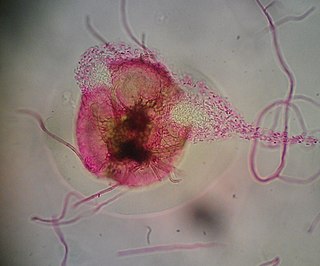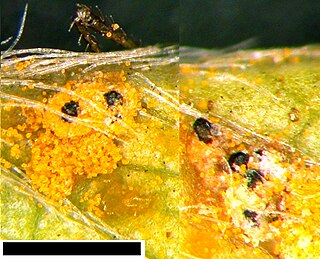
Rusts are fungal plant pathogens of the order Pucciniales causing plant fungal diseases.
This is a glossary of some of the terms used in phytopathology.

Botryosphaeria dothidea is a plant pathogen that causes the formation of cankers on a wide variety of tree and shrub species. It has been reported on several hundred plant hosts and on all continents except Antarctica. B. dothidea was redefined in 2004, and some reports of its host range from prior to that time likely include species that have since been placed in another genus. Even so, B. dothidea has since been identified on a number of woody plants—including grape, mango, olive, eucalyptus, maple, and oak, among others—and is still expected to have a broad geographical distribution. While it is best known as a pathogen, the species has also been identified as an endophyte, existing in association with plant tissues on which disease symptoms were not observed. It can colonize some fruits, in addition to woody tissues.
Alternaria triticina is a fungal plant pathogen that causes leaf blight on wheat. A. triticina is responsible for the largest leaf blight issue in wheat and also causes disease in other major cereal grain crops. It was first identified in India in 1962 and still causes significant yield loss to wheat crops on the Indian subcontinent. The disease is caused by a fungal pathogen and causes necrotic leaf lesions and in severe cases shriveling of the leaves.

Gibberella zeae, also known by the name of its anamorph Fusarium graminearum, is a fungal plant pathogen which causes fusarium head blight (FHB), a devastating disease on wheat and barley. The pathogen is responsible for billions of dollars in economic losses worldwide each year. Infection causes shifts in the amino acid composition of wheat, resulting in shriveled kernels and contaminating the remaining grain with mycotoxins, mainly deoxynivalenol (DON), which inhibits protein biosynthesis; and zearalenone, an estrogenic mycotoxin. These toxins cause vomiting, liver damage, and reproductive defects in livestock, and are harmful to humans through contaminated food. Despite great efforts to find resistance genes against F. graminearum, no completely resistant variety is currently available. Research on the biology of F. graminearum is directed towards gaining insight into more details about the infection process and reveal weak spots in the life cycle of this pathogen to develop fungicides that can protect wheat from scab infection.

Zymoseptoria tritici, synonyms Septoria tritici, Mycosphaerella graminicola, is a species of filamentous fungus, an ascomycete in the family Mycosphaerellaceae. It is a wheat plant pathogen causing septoria leaf blotch that is difficult to control due to resistance to multiple fungicides. The pathogen today causes one of the most important diseases of wheat.
Septoria campanulae is a fungal plant pathogen infecting bellflowers. It is closely related to other species from hosts in Apiaceae, such as Septoria aegopodina and Septoria oenanthis.
Phaeosphaeria avenaria f.sp. avenaria is a plant pathogen affecting oat. This f. sp. appears to not infect barley or rye, while their f. sp. (tritici) does not appear to infect oat.

Stagonospora is a genus of fungi clustering in the Phaeosphaeriaceae (Quaedvlieg). Several of the species in this genus are plant pathogens.

The Pleosporales is the largest order in the fungal class Dothideomycetes. By a 2008 estimate, it contained 23 families, 332 genera and more than 4700 species. The majority of species are saprobes on decaying plant material in fresh water, marine, or terrestrial environments, but several species are also associated with living plants as parasites, epiphytes or endophytes. The best studied species cause plant diseases on important agricultural crops e.g. Cochliobolus heterostrophus, causing southern corn leaf blight on maize, Phaeosphaeria nodorum causing glume blotch on wheat and Leptosphaeria maculans causing a stem canker on cabbage crops (Brassica). Some species of Pleosporales occur on animal dung, and a small number occur as lichens and rock-inhabiting fungi.

A pycnidium is an asexual fruiting body produced by mitosporic fungi, for instance in the order Sphaeropsidales or order Pleosporales. It is often spherical or inversely pearshaped (obpyriform) and its internal cavity is lined with conidiophores. When ripe, an opening generally appears at the top, through which the pycnidiospores escape.

The Phaeosphaeriaceae are a family of fungi in the order Pleosporales. Species in the family have a cosmopolitan distribution, and are generally nectrotrophic or saprobic on a wide range of plants.

The Massarinaceae are a family of fungi in the order Pleosporales. Although taxa have a cosmopolitan distribution, they are better-known in temperate regions. They are thought to be saprobic in wood and bark; some species are weak pathogens.

Neofabraea is a genus of fungi in the family Dermateaceae. The genus contains 12 species.
Septoria musiva, correct taxonomic name: Sphaerulina musiva, is an ascomycete fungus responsible of a leaf spot and canker disease on poplar trees. It is native on the eastern cottonwood poplar Populus deltoides, causing only a leaf spot symptom. On susceptible hybrid poplars, S. musiva causes necrotic lesions on the leaves which lead to premature defoliation, and cankers on the stem and branches which can reduce growth, predispose the tree to colonisation by secondary organisms, and cause stem breakage.

Pecan scab is the most economically significant disease of pecan trees in the southeastern United States. Venturia effusa is a fungal plant pathogen that causes pecan scab. The fungus causes lesions and tissue death on pecan twigs, petioles, leaves, nuts and shucks beginning in early spring, with multiple cycles of infection repeating until late summer. Wind and rain spread the fungus to a susceptible host. Control of the disease is achieved by fungicide, sanitation and, in some cases, quarantine.

Coniothyrium is a genus of fungi in the family Coniothyriaceae. The genus was circumscribed by Czech mycologist August Carl Joseph Corda in 1840. It was formerly placed in the Phaeosphaeriaceae family until 1983 when the family was established.

Cladosporium cladosporioides is a darkly pigmented mold that occurs world-wide on a wide range of materials both outdoors and indoors. It is one of the most common fungi in outdoor air where its spores are important in seasonal allergic disease. While this species rarely causes invasive disease in animals, it is an important agent of plant disease, attacking both the leaves and fruits of many plants. This species produces asexual spores in delicate, branched chains that break apart readily and drift in the air. It is able to grow under low water conditions and at very low temperatures.
Phoma wilt is a disease of the common hop plant caused by several species of fungal plant pathogens in the genus Phoma. These include Phoma herbarum and Phoma exigua, and possibly other as yet unidentified species. Phoma infection may cause decreased yields, but Phoma wilt is not considered to be a very common or destructive disease of the hop plant.

Coniothyriaceae is a family of ascomycetous marine based fungi within the order of Pleosporales in the subclass Pleosporomycetidae and within the class Dothideomycetes. They are pathogenic or they can be saprobic on dead branches. They are generally a anamorphic species.













